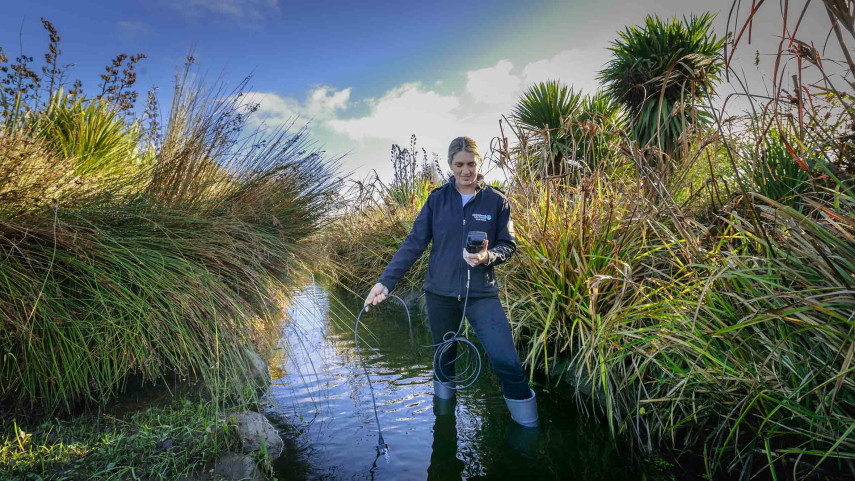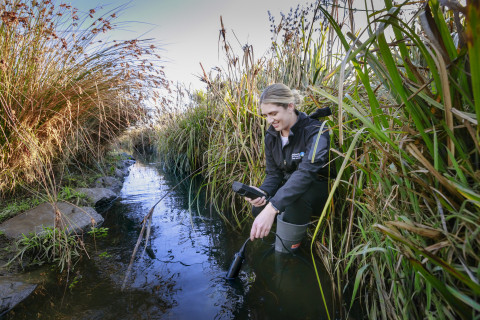
Improving the health of our waterways

Share this story
With winter rains finally upon us we caught up with Principal Waterways Ecologist at Christchurch City Council Katie Noakes, to talk about urban rivers and streams, the creatures that live in them and how stormwater runoff affects their ability to survive
Many of our waterways are spring fed, so what causes the water quality to decline?
Our larger rivers such as the Ōtākaro – Avon and Pūharakekenui – Styx come from aquifers fed by rainfall and the Waimakariri River. These spring sources are influenced by land use in the Canterbury Plains and can be low in stormwater contaminants like metals but may also have elevated nutrients. As these waterways flow from their spring sources, they intercept groundwater, flow through heavily urbanised areas and receive stormwater and other inputs. Stormwater treatment has been a requirement for all new subdivisions built in the last 20 or 30 years, but much of Christchurch was built before this time, which means contaminants from roads and roofs run straight into our waterways, resulting in declining water quality with distance from the spring source.

Principal Waterways Ecologist Katie Noakes checks the water quality in the Sparks Road wetlands with a hand held meter.
It’s not just water quality that’s affected; the built environment results in rainwater running off into waterways faster, creating more flashy, disturbed systems to live in. In addition, the habitat of fish within the stream and animals living beside the stream, such as birds, lizards, and insects are affected by removal of streamside plants, channel straightening, river maintenance, and roads, pipes, and culverts blocking their migratory corridors. The combination of these urban impacts on waterways is referred to as Urban Stream Syndrome, and it is endemic to urban centres across the world. Improving the health of urban waterways therefore requires addressing all the ailments, not just water quality.
What's living in our rivers and streams - are there any rare or endangered species?
Christchurch waterways are home to a number of native fish (such as eels, bullies and whitebait) and aquatic insects. Some of these are threatened or considered mahinga kai.
The majority of New Zealand freshwater fish are migratory, meaning they need to travel between the ocean and freshwater environments to complete their lifecycles. In particular, we have large spawning grounds for the at-risk Inanga, one of five whitebait species, and one of the few known spawning grounds for the nationally vulnerable kanakana/lamprey. We also have a number of sites throughout the city where at-risk kōura/freshwater crayfish and kākahi/freshwater mussels are found.
The more rural catchments such as those in Banks Peninsula and the Ōtūkaikino, also record good water quality and some sensitive species not found in the city, such as fish like kōaro and banded kokopu. There are also some aquatic insect species that are endemic to Banks Peninsula, meaning they are found nowhere else in New Zealand, or the rest of the world.

Tuna/freshwater eel are among the native species found in Christchurch waterways including this one, photographed in the Ōtākaro – Avon River.
What do these creatures need from their environment?
Fish and aquatic invertebrates need a range of conditions to survive and thrive: the most important aspects are clean water, abundant and diverse habitat and a range of food sources.
They need clean, clear and good quality water without sediment, chemicals or toxins, and a range of abundant and diverse habitat such as clean gravels for spawning, earth banks to burrow into and over-hanging vegetation to provide cover.
What happens when pollutants enter the environment through the stormwater system?
When it rains, or we wash things outside, the runoff goes into the stormwater network and likely discharges directly into our waterways. Pollutants entering waterways from the stormwater system can include a range of different contaminants. These contaminants can degrade water quality and, in some cases, (such as copper and zinc) are toxic to aquatic life. Sediment, from building and construction sites, is another contaminant that impacts aquatic life by blocking the gills of species, smothering habitat and affecting the behaviour of species by reducing light/ vision.
How can people keep pollutants out of stormwater?
Everyone can do their bit to help. At home, people can reduce the contaminants that wash off their property when it rains. This includes keeping garden waste and soil contained (e.g. in green bins), keeping gutters clear of debris such as leaves and rubbish and making sure chemicals and paints are contained and not left to wash down the stormwater grates. Reducing the number of chemicals used around the home (i.e. driveway cleaners) and not cleaning paintbrushes or other equipment outside in stormwater drains, but making sure this goes to the wastewater network. Roofs are one of the largest sources of zinc in the stormwater network, particularly old, worn roof material. It is important people keep on top of their roof maintenance by painting or replacing them when required to stop heavy metals getting into the stormwater system. Washing cars is another way contaminants can enter the network so making sure to wash cars on the grass or at a car wash facility. Environment Canterbury has some great resources online for those who would like to know more https://www.ecan.govt.nz/your-region/your-environment/water/stormwater/protect-our-waterways/#e9972
If people see any sediment, dirt or chemicals spilt or discharging into the stormwater network, take photos and use the Snap, Send Solve app to report it to ensure it doesn’t make its way to our waterways!
